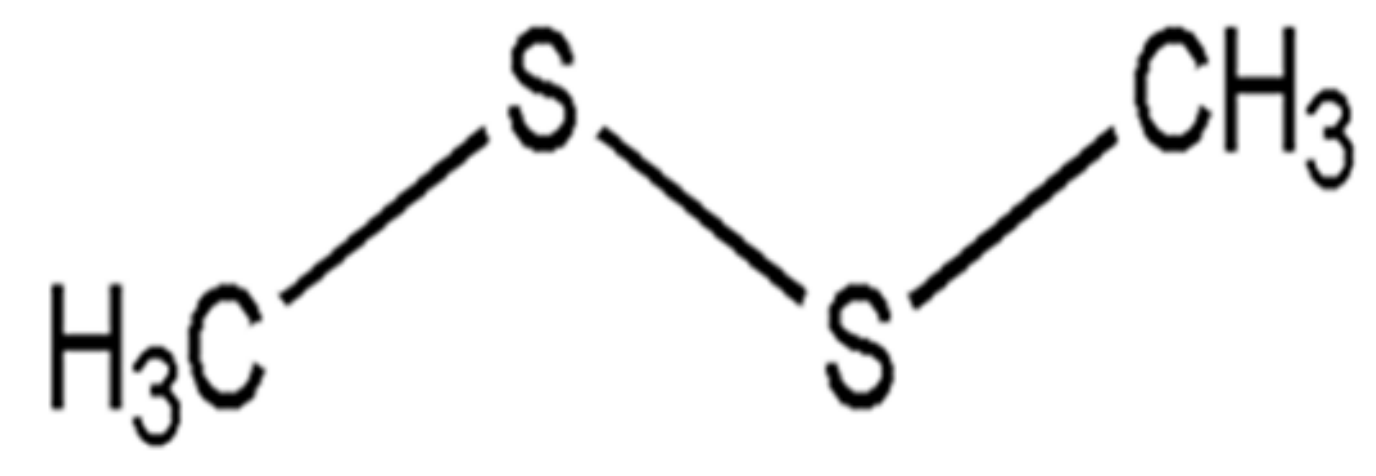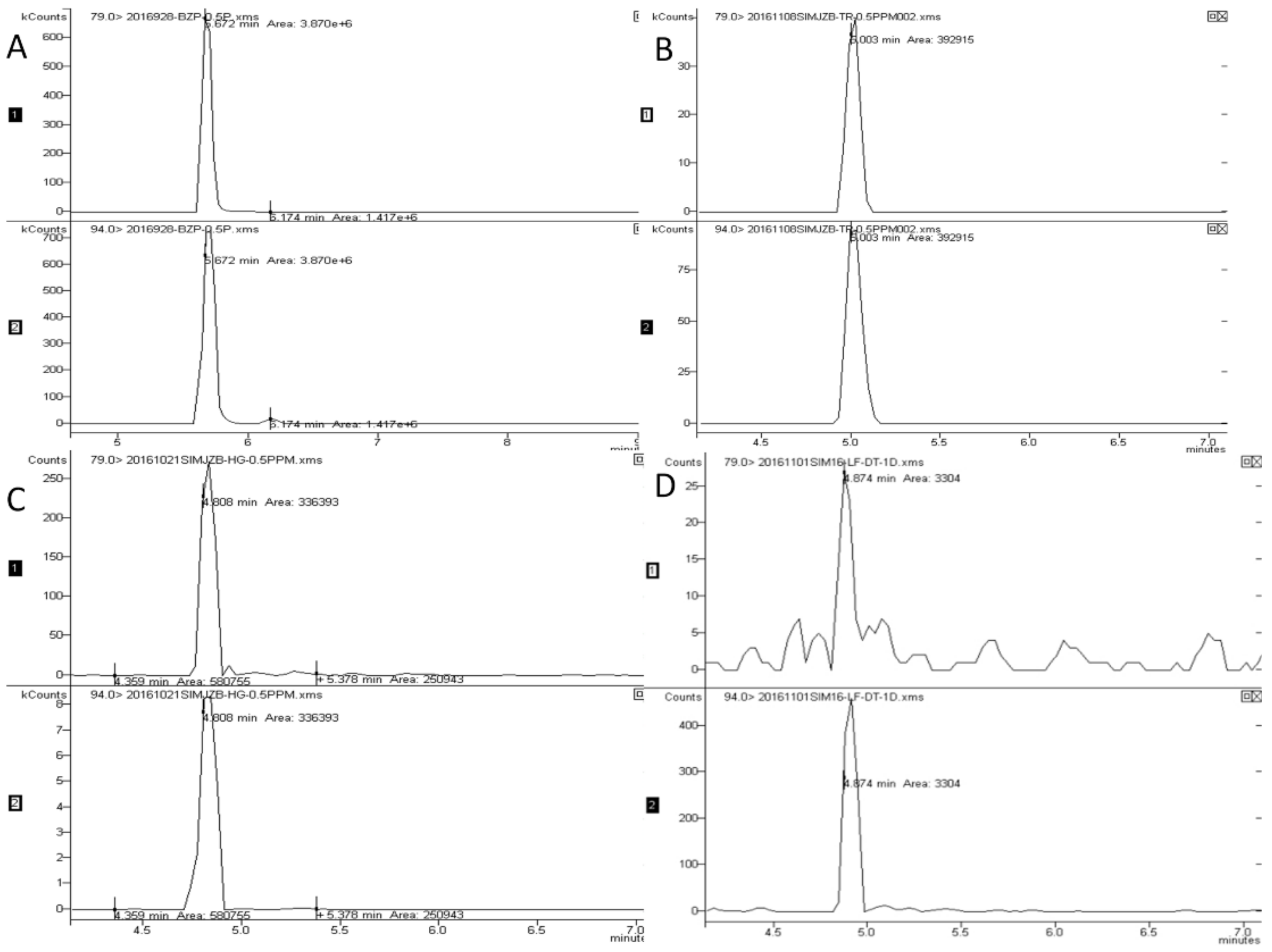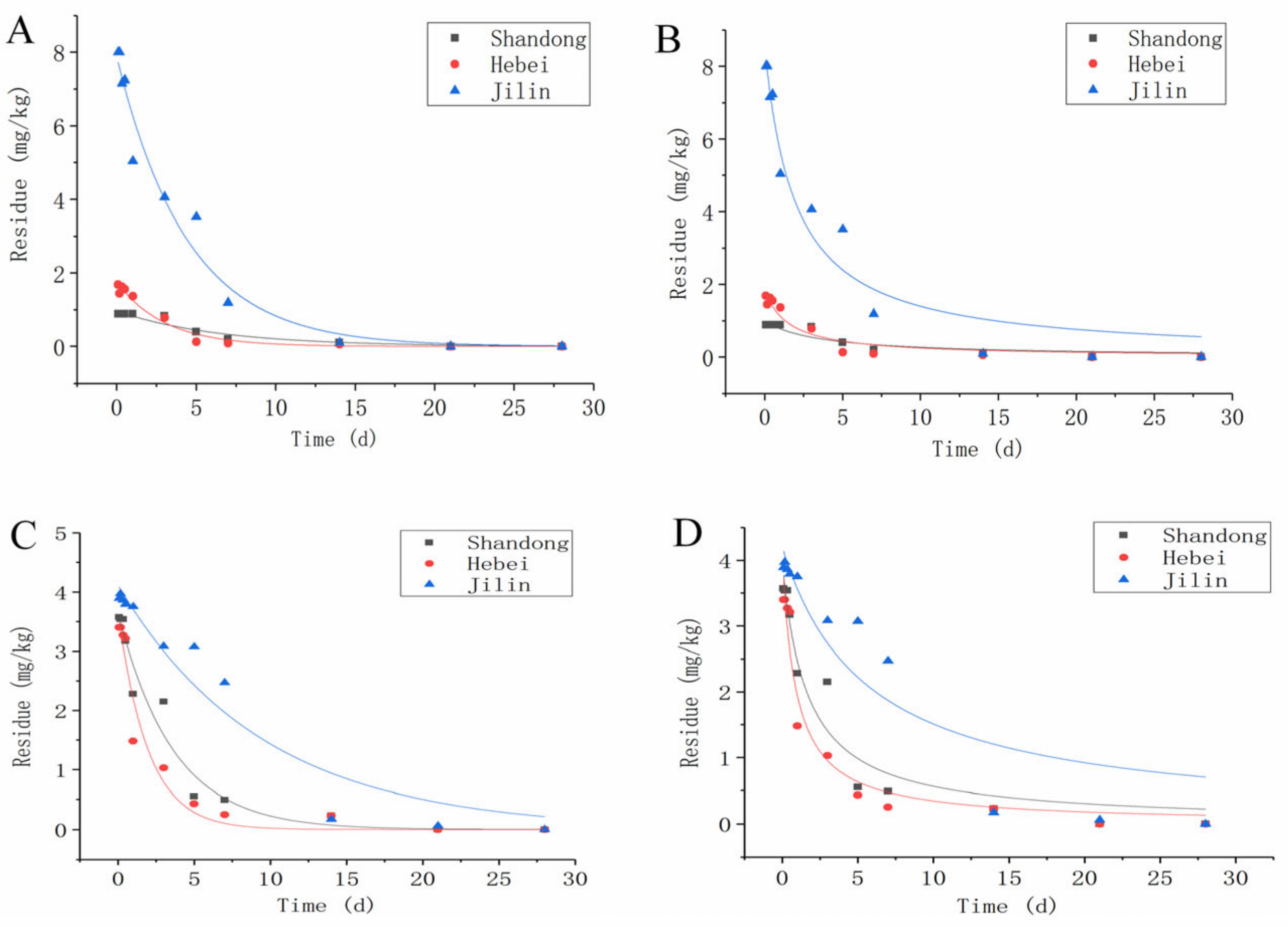Method Validation and Dissipation Behaviour of Dimethyl Disulphide (DMDS) in Cucumber and Soil by Gas Chromatography-Tandem Mass Spectrometry
Abstract
:1. Introduction
2. Materials and Methods
2.1. Standards and Reagents
2.2. Field Study
2.3. Sample Preparation Procedure
2.4. Instrumental and Analytical Conditions
2.5. Method Validation
2.6. Statistical Analysis
3. Results and Discussion
3.1. Validation of the Method
3.1.1. Matrix Effects, Linearity, LODs and LOQs
3.1.2. Optimization of the Extraction Method
3.1.3. Accuracy and Precision
3.2. Dissipation Dynamics
3.2.1. Dissipation of DMDS in Soil
3.2.2. Dissipation of DMDS in Cucumber
3.2.3. The Final Residue of DMDS in Cucumber and Soil
4. Conclusions
Author Contributions
Funding
Acknowledgments
Conflicts of Interest
References
- Singh, B.; Gupta, A. Monitoring of Pesticide Residues in Different Sources of Drinking Water of Jaipur, India. Bull. Environ. Contam. Toxicol. 2002, 69, 49–53. [Google Scholar] [CrossRef] [PubMed]
- Triky-Dotan, S.; Westerdahl, B.; Martin, F.N.; Subbarao, K.; Koike, S.T.; Ajwa, H.A. Fumigant Dosages below Maximum Label Rate Control Some Soilborne Pathogens. Calif. Agric. 2016, 70, 130–136. [Google Scholar] [CrossRef]
- Taylor, R. Facing the Future without Methyl Bromide—Are Alternatives Available to This Versatile Fumigant? Phytoparasitica 2001, 29, 3–6. [Google Scholar] [CrossRef]
- UNEP. Report of the Methyl Bromide Technical Options Committee; UNEP: Nairobi, Kenya, 2014. [Google Scholar]
- Rosskopf, E.N.; Chellemi, D.O.; Kokalis-Burelle, N.; Church, G.T. Alternatives to Methyl Bromide: A Florida Perspective. Plant Health Prog. 2005, 6, 19. [Google Scholar] [CrossRef]
- Fritsch, J. Dimethyl Disulfide as a New Chemical Potential Alternative to Methyl Bromide in Soil Disinfestation in France. Acta Hortic. 2005, 698, 71–76. [Google Scholar] [CrossRef]
- Coosemans, J. Dimethyl Disulphide (DMDS): A Potential Novel Nematicide and Soil Disinfectant. Acta Hortic. 2005, 698, 57–64. [Google Scholar] [CrossRef]
- U.S. Environmental Protection Agency. Pesticide Fact Sheet Name of Chemical: Dimethyl Disulfide Reason for Issuance: New Chemical; U.S. Environmental Protection Agency: Washington, DC, USA, 2010. [Google Scholar]
- Cebolla, V.; Llobell, D.; Oliver, A.; Valero, L.M.; Torro, F.; Hernandez, A. The emulsifiable formulations of dimethyldisulfide (DMDS) and its mixtures with chloropicrin as alternatives to methyl bromide. In Acta Horticulturae; International Society for Horticultural Science: Leuven, Belgium, 2010; Volume 883, pp. 163–170. [Google Scholar] [CrossRef]
- Zanón, M.J.; Gutiérrez, L.A.; Myrta, A. Spanish Experiences with Dimethyl Disulfide (DMDS) on the Control of Root-Knot Nematodes, Meloidogyne Spp., in Fruiting Vegetables in Protected Crops. Acta Hortic. 2014, 1044, 421–425. [Google Scholar] [CrossRef]
- Heller, J.J.; Sunder, P.; Charles, P.; Pommier, J.J.; Fritsch, J. Dimethyl Disulfide, a New Alternative to Existing Fumigants on Strawberries in France and Italy. Acta Hortic. 2009, 842, 953–956. [Google Scholar] [CrossRef]
- Myrta, A.; Santori, A.; Zanón, M.J.; Tsimboukis, N.; De Vries, R.; De Tommaso, N. Effectiveness of dimethyl disulfide (DMDS) for management of root-knot nematode in protected tomatoes in Southern Europe. In Acta Horticulturae; International Society for Horticultural Science: Leuven, Belgium, 2018; Volume 1207, pp. 123–127. [Google Scholar] [CrossRef]
- Mao, L.; Yan, D.; Wang, Q.; Li, Y.; Ouyang, C.; Liu, P.; Shen, J.; Guo, M.; Cao, A. Evaluation of the Combination of Dimethyl Disulfide and Dazomet as an Efficient Methyl Bromide Alternative for Cucumber Production in China. J. Agric. Food Chem. 2014, 62, 4864–4869. [Google Scholar] [CrossRef]
- Arnault, I.; Fleurance, C.; Vey, F.; Fretay, G.D.; Auger, J. Use of Alliaceae Residues to Control Soil-Borne Pathogens. Ind. Crop. Prod. 2013, 49, 265–272. [Google Scholar] [CrossRef]
- Gilardi, G.; Gullino, M.L.; Garibaldi, A. Soil Disinfestation with Dimethyl Disulfide for Management of Fusarium Wilt on Lettuce in Italy. J. Plant Dis. Prot. 2017, 124, 361–370. [Google Scholar] [CrossRef]
- Leocata, S.; Pirruccio, G.; Myrta, A.; Medico, E.; Greco, N. Dimethyl Disulfide (DMDS): A New Soil Fumigant to Control Root-Knot Nematodes, Meloidogyne Spp., in Protected Crops in Sicily, Italy. Acta Hortic. 2014, 1044, 415–420. [Google Scholar] [CrossRef]
- Gómez-Tenorio, M.A.; Tello, J.C.; Zanón, M.J.; de Cara, M. Soil Disinfestation with Dimethyl Disulfide (DMDS) to Control Meloidogyne and Fusarium Oxysporum f. Sp. Radicis-Lycopersici in a Tomato Greenhouse. Crop Prot. 2018, 112, 133–140. [Google Scholar] [CrossRef]
- Gamliel, A.; Triky-Dotan, S. Accelerated degradation of soil fumigants: Occurrence and agricultural consequences. In Recent Developments in Management of Plant Diseases; Springer Netherlands: Dordrecht, The Netherlands, 2010; pp. 311–328. [Google Scholar] [CrossRef]
- Ou, L.T.; Thomas, J.E.; Allen, L.H.; McCormack, L.A.; Vu, J.C.; Dickson, D.W. Effects of Application Methods and Plastic Covers on Distribution of Cis- and Trans-1,3-Dichloropropene and Chloropicrin in Root Zone. J. Nematol. 2005, 37, 483–488. [Google Scholar]
- Conkle, J.L.; Cabrera, J.A.; Thomas, J.E.; Wang, D.; Gan, J. Effects of CO2 Dissolution on Phase Distribution and Degradation of Dimethyl Disulfide in Soils under Grape Production. Pest Manag. Sci. 2016, 72, 349–353. [Google Scholar] [CrossRef]
- Lv, L.; Zhang, J.; Huang, C.; Lei, Z.; Chen, B. Adsorptive Separation of Dimethyl Disulfide from Liquefied Petroleum Gas by Different Zeolites and Selectivity Study via FT-IR. Sep. Purif. Technol. 2014, 125, 247–255. [Google Scholar] [CrossRef]
- Perraud, V.; Meinardi, S.; Blake, D.R.; Finlayson-Pitts, B.J. Challenges Associated with the Sampling and Analysis of Organosulfur Compounds in Air Using Real-Time PTR-ToF-MS and Offline GC-FID. Atmos. Meas. Tech. 2016, 9, 1325–1340. [Google Scholar] [CrossRef]
- Han, D.; Wang, Q.; Liu, P.; Fang, W.; Yan, D.; Cao, A. Dimethyl Disulphide Residue Analysis and Degradation Kinetics Determination in Soil Using Gas Chromatography–Mass Spectrometry. Int. J. Environ. Anal. Chem. 2016, 96, 694–704. [Google Scholar] [CrossRef]
- FAO. Guidelines on Efficacy Data for the Registration of Pesticides; FAO: Rome, Italy, 1985. [Google Scholar]
- EC (EUROPEAN COMMISSION). SANTE/11813/2017. Guidance Document on Analytical Quality Control and Method Validation Procedures for Pesticide Residues and Analysis in Food and Feed. EC (EUROPEAN COMMISSION). Available online: https://doi.org/10.13140/RG.2.2.33021.77283 (accessed on 21 November 2017).
- Anastassiades, M.; Lehotay, S.J. Fast and Easy Multiresidue Method Employing Acetonitrile Extraction_Partitioning and “Dispersive Solid-Phase Extraction” for the Determination of Pesticide Residues in Produce. J. AOCA Int. 2003, 86, 412–431. [Google Scholar]
- Zhao, P.; Wang, L.; Zhou, L.; Zhang, F.; Kang, S.; Pan, C. Multi-Walled Carbon Nanotubes as Alternative Reversed-Dispersive Solid Phase Extraction Materials in Pesticide Multi-Residue Analysis with QuEChERS Method. J. Chromatogr. A 2012, 1225, 17–25. [Google Scholar] [CrossRef]
- Xie, T.; Reddy, K.R.; Wang, C.; Yargicoglu, E.; Spokas, K. Characteristics and Applications of Biochar for Environmental Remediation: A Review. Crit. Rev. Environ. Sci. Technol. 2015, 45, 939–969. [Google Scholar] [CrossRef]
- Smernik, R.J. Biochar and sorption of organic compounds. In Biochar for Environmental Management: Science and Technology, 1st ed.; Lehmann, J., Joseph, S., Eds.; Taylor and Francis: London, UK, 2012; pp. 289–300. [Google Scholar] [CrossRef]
- Salazar, J.D. Review of the Statistical Procedures Currently in Use for the Calculation of Maximum Residue Limits. Outlooks Pest Manag. 2011, 22, 74–76. [Google Scholar] [CrossRef]
- Gottschalk, F.; Sun, T.; Nowack, B. Environmental Concentrations of Engineered Nanomaterials: Review of Modeling and Analytical Studies. Environ. Pollut. 2013, 181, 287–300. [Google Scholar] [CrossRef] [PubMed]
- Pennell, K.D.; Hornsby, A.G.; Jessup, R.E.; Rao, P.S.C. Evaluation of Five Simulation Models for Predicting Aldicarb and Bromide Behavior Under Field Conditions. Water Resour. Res. 1990, 26, 2679–2693. [Google Scholar] [CrossRef]
- Weed, D.A.J.; Kanwar, R.S.; Stoltenberg, D.E.; Pfeiffer, R.L. Dissipation and Distribution of Herbicides in the Soil Profile. J. Environ. Qual. 1995, 24, 68–79. [Google Scholar] [CrossRef]
- Racke, K.D.; Skidmore, M.W.; Hamilton, D.J.; Unsworth, J.B.; Miyamoto, J.; Cohen, S.Z.; Holland, P.T. Pesticide Fate in Tropical Soils. Pure Appl. Chem. 1997, 69, 1349–1371. [Google Scholar] [CrossRef]




| Experimental Sites | Climate | Average Annual Rainfall (mm) | Average Annual Temperature (°C) | Soil Type | Organic-Matter (%) | Soil pH |
|---|---|---|---|---|---|---|
| Shandong | semi-humid monsoon | 900–750 | 13 | Brown soil | 2 | 7.15 |
| Jilin | temperate monsoon | 400–600 | 17 | Sandy loam | 3.40 | 7.3 |
| Hebei | temperate monsoon | 400–800 | 11 | Clay | 1.80 | 6.5 |
| Matrix | Calibration Equation | Coefficient (R2) | P Value | LOD (mg/kg) | LOQ (mg/kg) |
|---|---|---|---|---|---|
| Dichloromethane | y = 8656123 x + 719091 | 0.9996 | - | 0.012 | 0.05 |
| Cucumber | y = 6808925 x − 936245 | 0.9956 | 0.041 | 0.015 | 0.05 |
| Soil | y = 7811030 x + 1803515 | 0.9953 | 0.49 | 0.015 | 0.05 |
| Matrix | Spiking 0.05 mg/kg | Spiking 0.5 mg/kg | Spiking 5 mg/kg | |||
|---|---|---|---|---|---|---|
| Mean Recovery (%) | RSD (%) | Mean Recovery (%) | RSD (%) | Mean Recovery (%) | RSD (%) | |
| Cucumber | 83.98 | 6.5 | 90.28 | 0.5 | 101.51 | 3.8 |
| Soil | 74.07 | 4.9 | 84.33 | 0.7 | 98.69 | 4.8 |
| Time (year) | Locality | First-Order Kinetic Equation | Second-Order Kinetic Equation | ||||
|---|---|---|---|---|---|---|---|
| Regression Equation | Coefficient (R2) | Half-Life (day) | Regression Equation | Coefficient (R2) | Half-Life (day) | ||
| 2015 | Shandong | y = 0.96249e−0.15433x | 0.9498 | 4.47 | y = 0.98888/(1 + 0.2702x) | 0.8943 | 3.70 |
| Jilin | y = 7.86281e−0.22474x | 0.9720 | 3.07 | y = 8.5319/(1 + 0.5096x) | 0.958 | 1.96 | |
| Hebei | y = 1.74864e−0.32911x | 0.9757 | 2.10 | y = 1.8531/(1 + 0.6463x) | 0.9334 | 1.55 | |
| 2016 | Shandong | y = 3.64191e−0.27719x | 0.9628 | 2.49 | y = 3.9897/(1 + 0.614x) | 0.9441 | 1.63 |
| Jilin | y = 4.1209e−0.10624x | 0.9430 | 6.49 | y = 4.20337/(1 + 0.1799x) | 0.8679 | 5.56 | |
| Hebei | y = 3.66312e−0.51003x | 0.9618 | 1.35 | y = 4.05637/(1 + 0.3984x) | 0.9604 | 2.51 | |
© 2019 by the authors. Licensee MDPI, Basel, Switzerland. This article is an open access article distributed under the terms and conditions of the Creative Commons Attribution (CC BY) license (http://creativecommons.org/licenses/by/4.0/).
Share and Cite
Kaium, A.; Cao, J.; Liu, X.; Xu, J.; Dong, F.; Wu, X.; Zheng, Y. Method Validation and Dissipation Behaviour of Dimethyl Disulphide (DMDS) in Cucumber and Soil by Gas Chromatography-Tandem Mass Spectrometry. Int. J. Environ. Res. Public Health 2019, 16, 4493. https://doi.org/10.3390/ijerph16224493
Kaium A, Cao J, Liu X, Xu J, Dong F, Wu X, Zheng Y. Method Validation and Dissipation Behaviour of Dimethyl Disulphide (DMDS) in Cucumber and Soil by Gas Chromatography-Tandem Mass Spectrometry. International Journal of Environmental Research and Public Health. 2019; 16(22):4493. https://doi.org/10.3390/ijerph16224493
Chicago/Turabian StyleKaium, Abdul, Junli Cao, Xingang Liu, Jun Xu, Fengshou Dong, Xiaohu Wu, and Yongquan Zheng. 2019. "Method Validation and Dissipation Behaviour of Dimethyl Disulphide (DMDS) in Cucumber and Soil by Gas Chromatography-Tandem Mass Spectrometry" International Journal of Environmental Research and Public Health 16, no. 22: 4493. https://doi.org/10.3390/ijerph16224493







